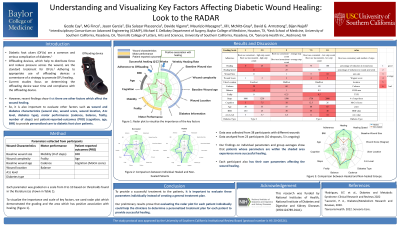Clinical Research
(CR-007) Understanding and Visualizing Key Factors Affecting Diabetic Wound Healing: Look to the RADAR
Friday, April 28, 2023
7:15 PM - 8:30 PM East Coast USA Time

MG Finco, PhD – Interdisciplinary Consortium on Advanced Motion Performance (iCAMP), Michael E. DeBakey Department of Surgery – Baylor College of Medicine; Jason Garcia, BA – Keck School of Medicine – University of Southern California; Elia Salazar, Ed.D, MPH – Keck School of Medicine – University of Southern California; Davide Vigano, BS – Sensoria Health Inc.; Maurizio Macagno, MS – Sensoria Health Inc.; Jill McNitt-Gray, PhD – Dornsife College of Letters, Arts and Sciences – University of Southern California; David Armstrong, DPM, MD, PhD – Keck School of Medicine – University of Southern California; Bijan Najafi, PhD – Interdisciplinary Consortium on Advanced Engineering (iCAMP), Michael E. DeBakey Department of Surgery – Baylor College of Medicine
Introduction: Diabetic foot ulcers (DFUs) are a common and serious complication of diabetes. Offloading devices, which help to distribute force and reduce pressure across the wound, are the standard treatment for DFUs. Adhering to appropriate use of offloading devices a cornerstone of a strategy to promote DFU healing. For this reason, current studies focus on determining the offloading device wear time and compliance with the offloading device. However, recent findings show that there are other factors which affect the wound healing. So, it is also important to evaluate other factors such as wound and diabetes characteristics (wound size, wound score, wound location, A1c level, diabetes type), motor performance (cadence, balance, frailty, number of steps) and patient-reported-outcomes (PRO) (cognition, age, BMI) to provide personalized care to diabetic foot ulcer patients.
Methods: In our study, we collected data from 38 participants with different wounds and analyzed data from 23 of these participants. The factors were graded on a scale from 0 to 10 based on thresholds found in the literature (as shown in Table 1). To visualize the importance and scale of key factors, we used radar plot which demonstrated the grading and the area which has positive association with healing. Figure 1 shows the radar plot visualization with the shaded area.
Results: To understand the factors affecting the wound healing, the data collected from the participants were graded individually and separate radar plots were created for each participant. Figure 2 shows the difference between two patients who are healed and non-healed and how their parameters are scaled. We also calculated the average grading for the participants who healed and non-healed and demonstrated in Figure 3. The figure shows that healed group’s parameters were more within the green area than the non-healed group’s parameters.
Discussion: Our findings on individual parameters and group averages show that patients whose parameters are within the shaded area experience more successful healing. It is also seen that each participant has their own parameters affecting the wound healing. To provide a successful treatment to the patients, it is important to evaluate these parameters individually instead of creating a general treatment plan. Our preliminary results prove that evaluating the radar plot for each patient individually helps the clinicians to determine a personalized treatment plan for each patient to provide successful healing.
Methods: In our study, we collected data from 38 participants with different wounds and analyzed data from 23 of these participants. The factors were graded on a scale from 0 to 10 based on thresholds found in the literature (as shown in Table 1). To visualize the importance and scale of key factors, we used radar plot which demonstrated the grading and the area which has positive association with healing. Figure 1 shows the radar plot visualization with the shaded area.
Results: To understand the factors affecting the wound healing, the data collected from the participants were graded individually and separate radar plots were created for each participant. Figure 2 shows the difference between two patients who are healed and non-healed and how their parameters are scaled. We also calculated the average grading for the participants who healed and non-healed and demonstrated in Figure 3. The figure shows that healed group’s parameters were more within the green area than the non-healed group’s parameters.
Discussion: Our findings on individual parameters and group averages show that patients whose parameters are within the shaded area experience more successful healing. It is also seen that each participant has their own parameters affecting the wound healing. To provide a successful treatment to the patients, it is important to evaluate these parameters individually instead of creating a general treatment plan. Our preliminary results prove that evaluating the radar plot for each patient individually helps the clinicians to determine a personalized treatment plan for each patient to provide successful healing.

.png)